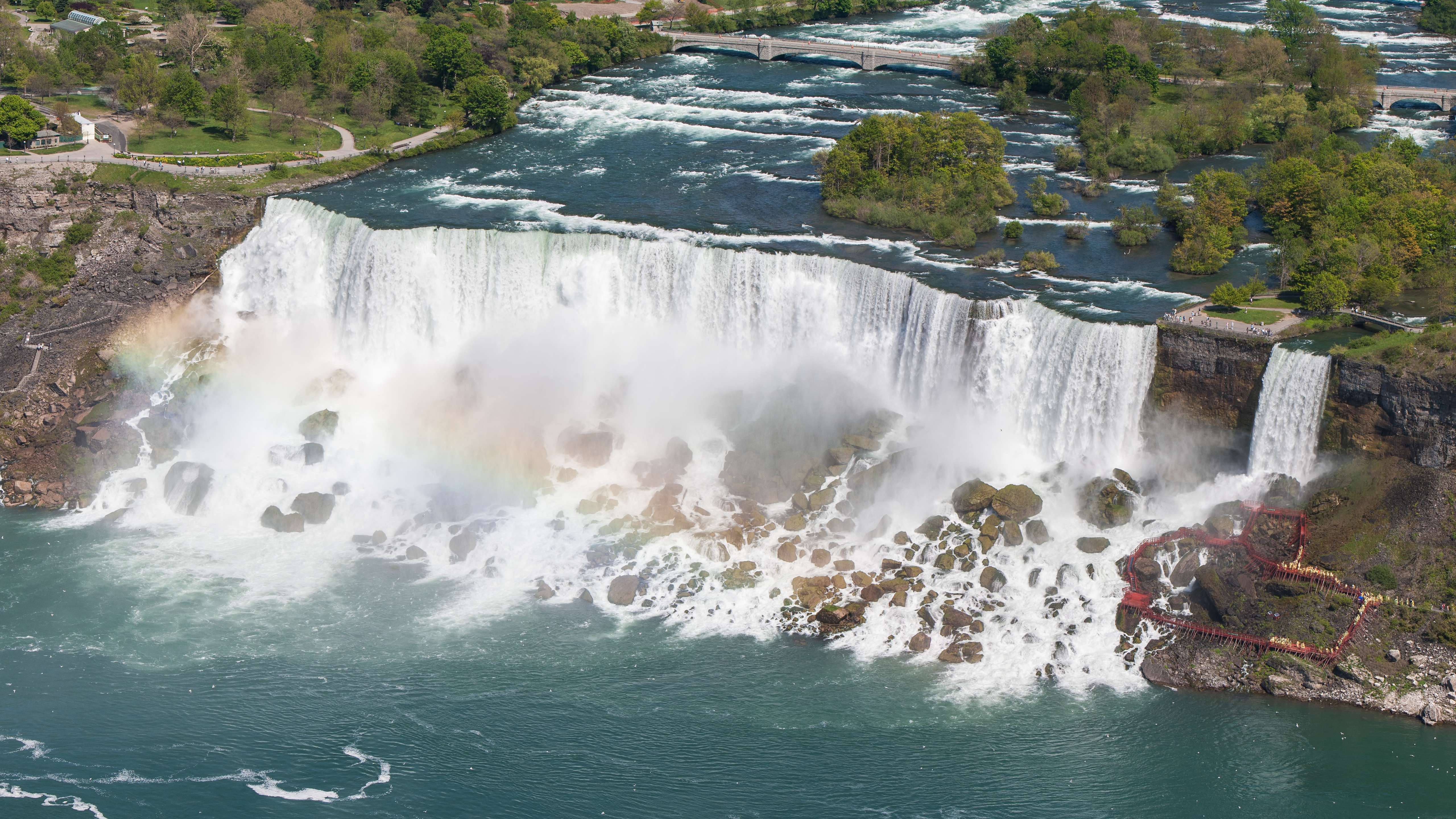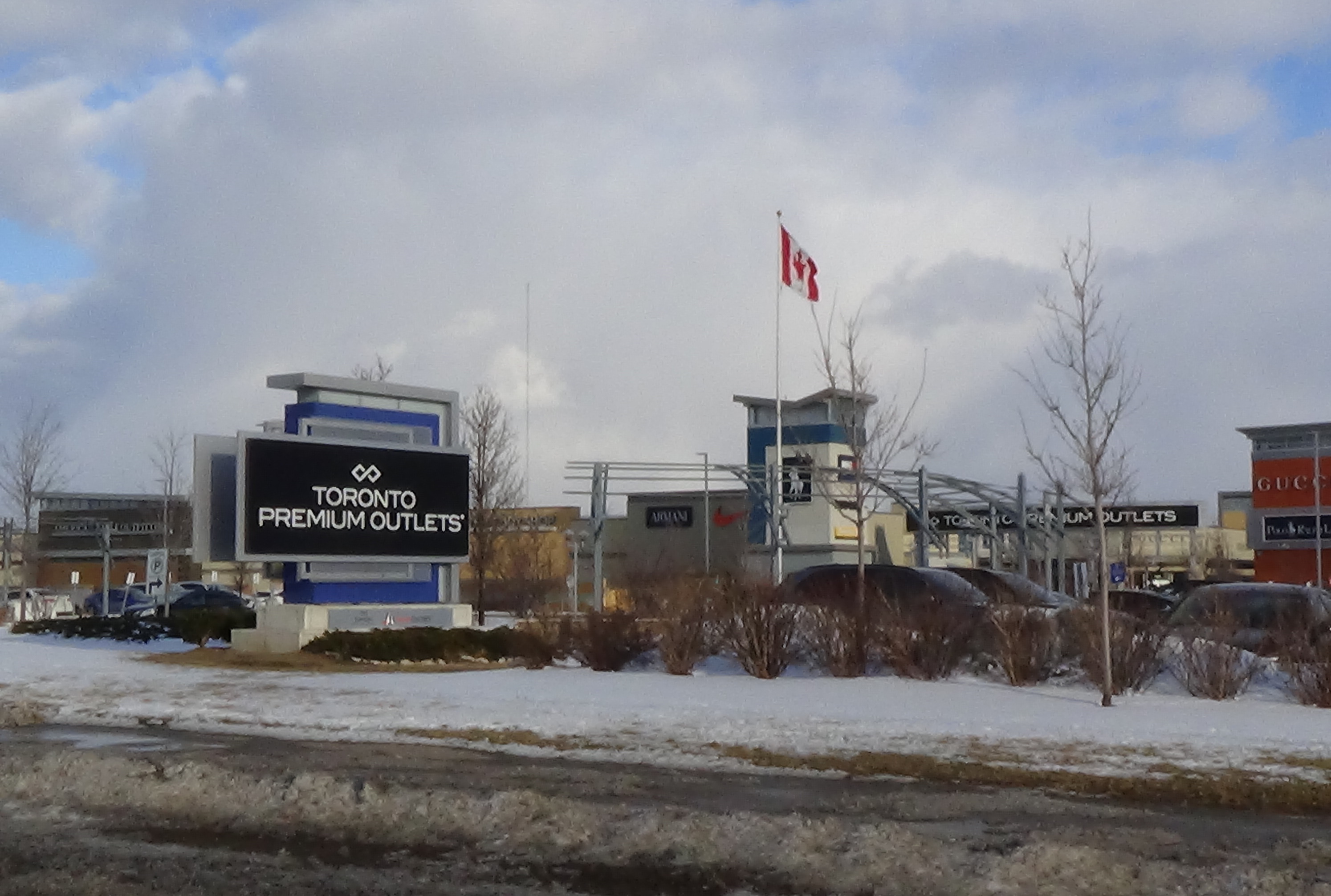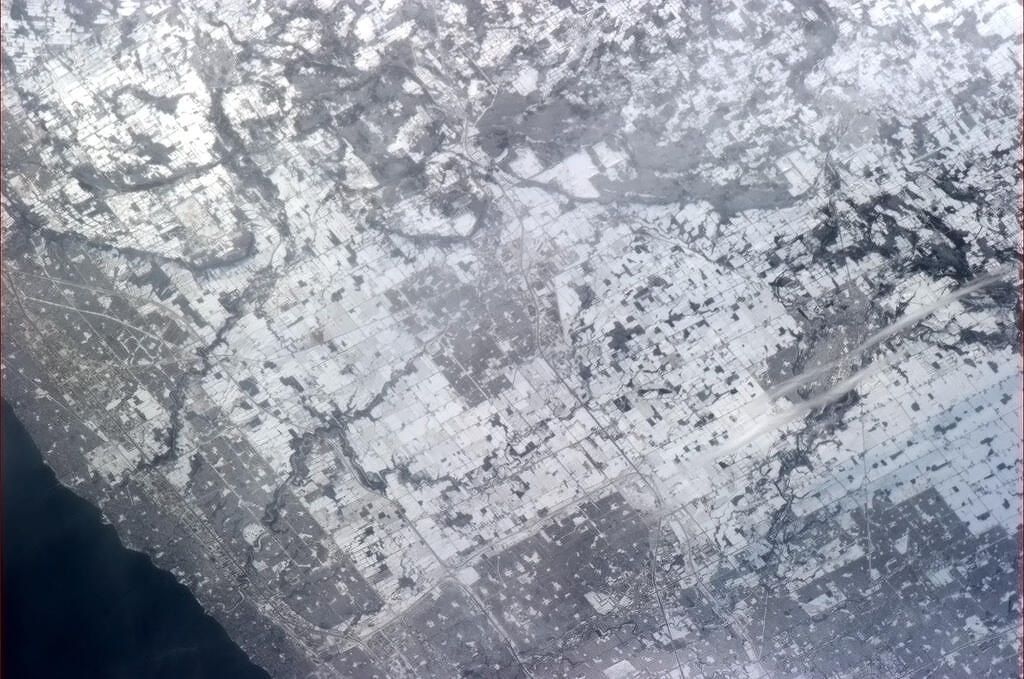|
Bruce Trail
The Bruce Trail is a hiking trail in southern Ontario, Canada, from the Niagara River to the tip of Tobermory, Ontario. The main trail is more than long and there are over of associated side trails. The trail mostly follows the edge of the Niagara Escarpment, one of the nineteen UNESCO World Biosphere Reserves in Canada. The land the trail traverses is owned by the Government of Ontario, local municipalities, local conservation authorities, private landowners, and the Bruce Trail Conservancy (BTC). The Bruce Trail is the oldest and longest marked hiking trail in Canada. Its name is linked to the Bruce Peninsula and Bruce County, through which the trail runs. The trail is named after the county, which was named after James Bruce, 8th Earl of Elgin who was Governor General of the Province of Canada from 1847 to 1854. History The idea for creating the Bruce Trail came about in 1959 out of a meeting between Ray Lowes and Robert Bateman, of the Federation of Ontario Natural ... [...More Info...] [...Related Items...] OR: [Wikipedia] [Google] [Baidu] |
Bruce Trail
The Bruce Trail is a hiking trail in southern Ontario, Canada, from the Niagara River to the tip of Tobermory, Ontario. The main trail is more than long and there are over of associated side trails. The trail mostly follows the edge of the Niagara Escarpment, one of the nineteen UNESCO World Biosphere Reserves in Canada. The land the trail traverses is owned by the Government of Ontario, local municipalities, local conservation authorities, private landowners, and the Bruce Trail Conservancy (BTC). The Bruce Trail is the oldest and longest marked hiking trail in Canada. Its name is linked to the Bruce Peninsula and Bruce County, through which the trail runs. The trail is named after the county, which was named after James Bruce, 8th Earl of Elgin who was Governor General of the Province of Canada from 1847 to 1854. History The idea for creating the Bruce Trail came about in 1959 out of a meeting between Ray Lowes and Robert Bateman, of the Federation of Ontario Natural ... [...More Info...] [...Related Items...] OR: [Wikipedia] [Google] [Baidu] |
Niagara Escarpment
The Niagara Escarpment is a long escarpment, or cuesta, in Canada and the United States that runs predominantly east–west from New York through Ontario, Michigan, Wisconsin, and into Illinois. The escarpment is most famous as the cliff over which the Niagara River plunges at Niagara Falls, for which it is named. The escarpment is a UNESCO World Biosphere Reserve. The reserve has the oldest forest ecosystem and trees in eastern North America. The escarpment is not a fault line but the result of unequal erosion. It is composed of an outcrop belt of the Lockport Formation of Silurian age, and is similar to the Onondaga Formation, which runs in a parallel outcrop belt just to the south, through western New York and southern Ontario. The escarpment is the most prominent of several escarpments formed in the bedrock of the Great Lakes Basin. From its easternmost point near Watertown, New York, the escarpment shapes in part the individual basins and landforms of Lake O ... [...More Info...] [...Related Items...] OR: [Wikipedia] [Google] [Baidu] |
Niagara Falls
Niagara Falls () is a group of three waterfalls at the southern end of Niagara Gorge, spanning the border between the province of Ontario in Canada and the state of New York in the United States. The largest of the three is Horseshoe Falls, which straddles the international border of the two countries. It is also known as the Canadian Falls. The smaller American Falls and Bridal Veil Falls lie within the United States. Bridal Veil Falls is separated from Horseshoe Falls by Goat Island and from American Falls by Luna Island, with both islands situated in New York. Formed by the Niagara River, which drains Lake Erie into Lake Ontario, the combined falls have the highest flow rate of any waterfall in North America that has a vertical drop of more than . During peak daytime tourist hours, more than of water goes over the crest of the falls every minute. Horseshoe Falls is the most powerful waterfall in North America, as measured by flow rate. Niagara Falls is famed for ... [...More Info...] [...Related Items...] OR: [Wikipedia] [Google] [Baidu] |
Owen Sound
Owen Sound ( 2021 Census population 21,612) is a city in Southwestern Ontario, Canada. The county seat of Grey County, it is located at the mouths of the Pottawatomi and Sydenham Rivers on an inlet of Georgian Bay. The primary tourist attractions are the many waterfalls within a short drive of the town. History The area around the upper Great Lakes has been home to the Ojibwe people since prehistory. In 1815, William Fitzwilliam Owen surveyed the area and named the inlet after his older brother Admiral Edward Owen. The name of the area in Ojibwe language is ''Gchi-wiigwedong''. A settlement called "Sydenham" was established in 1840 or 1841 by Charles Rankin in an area that had been inhabited by First Nations people. John Telfer settled here at that time and others followed. By 1846, the population was 150 and a sawmill and gristmill were operating. The name Sydenham continued even as the community became the seat for Grey County in 1852. An Ontario historical plaque e ... [...More Info...] [...Related Items...] OR: [Wikipedia] [Google] [Baidu] |
Chatsworth, Ontario
Chatsworth is a township municipality in south-western Ontario, Canada, in Grey County, located at the headwaters of the Styx River, the Saugeen River, the Sauble River, the Bighead River, the Spey River, and the old Sydenham River. The current township was formed in late year 2000 with the amalgamation of Holland Township, Sullivan Township, and the village of Chatsworth. The first white settlers arrived in this area in the early 19th century and a significant amount of settlement was underway in mid-to-late 1800s. Canadian suffragette and activist Nellie McClung was born in the town of Chatsworth. The Sullivan Township area has a large Amish population. Government The township is led by a municipal council consisting of a Mayor, a Deputy Mayor and three Council Members. The current Council, elected in 2018, comprises Scott Mackey as Mayor; Brian Gamble as Deputy mayor; and Shawn Greig, Elizabeth Thompson and Diana Rae as Councillors. Communities In addition to the to ... [...More Info...] [...Related Items...] OR: [Wikipedia] [Google] [Baidu] |
Halton Hills
) , image_map = , mapsize = 200px , map_caption = , pushpin_map = CAN ON Halton#Canada Southern Ontario , pushpin_map_caption = , coordinates = , subdivision_type = Country , subdivision_name = Canada , subdivision_type1 = Provinces and territories of Canada, Province , subdivision_name1 = Ontario , subdivision_type2 = Region , subdivision_name2 = Regional Municipality of Halton, Halton , established_title = , established_date = , established_title2 = Incorporated , established_date2 = 1974 , leader_title = Mayor , leader_name = Ann Lawlor , leader_title1 = Federal riding , leader_name1 = Wellington—Halton Hills , leader_title2 = Prov. riding , leader_name2 = Wellington—Halton Hills (provincial electoral district), Wellington—Halton Hills , area_footnotes ... [...More Info...] [...Related Items...] OR: [Wikipedia] [Google] [Baidu] |
Milton, Ontario
Milton (2016 census population 110,128) is a town in Southern Ontario, Canada, and part of the Halton Region in the Greater Toronto Area. Between 2001 and 2011, Milton was the fastest growing municipality in Canada, with a 71.4% increase in population from 2001 to 2006 and another 56.5% increase from 2006 to 2011. In 2016, Milton's census population was 110,128 with an estimated growth to 228,000 by 2031. It remained the fastest growing community in Ontario but was deemed to be the sixth fastest growing in Canada at that time. Consisting of of land area, Milton is located west of Downtown Toronto on Highway 401, and is the western terminus for the Milton line commuter train and bus corridor operated by GO Transit. Milton is situated on the Niagara Escarpment, a UNESCO world biosphere reserve and the Bruce Trail. History The Mississaugas of the Credit held 648,000 acres of land north of the Head of the Lake Purchase lands and extending to the unceded territory of the Chippewa ... [...More Info...] [...Related Items...] OR: [Wikipedia] [Google] [Baidu] |
Burlington, Ontario
Burlington is a city in the Regional Municipality of Halton at the northwestern end of Lake Ontario in Ontario, Canada. Along with Milton to the north, it forms the western end of the Greater Toronto Area and is also part of the Hamilton metropolitan census area. History Before the 19th century, the area between the provincial capital of York and the township of West Flamborough was home to the Mississauga nation. In 1792, John Graves Simcoe, the first lieutenant governor of Upper Canada, named the western end of Lake Ontario " Burlington Bay" after the town of Bridlington in the East Riding of Yorkshire, England. The British purchased the land on which Burlington now stands from the Mississaugas in Upper Canada Treaties 3 (1792), 8 (1797), 14 (1806), and 19 (1818). Treaty 8 concerned the purchase of the Brant Tract, on Burlington Bay which the British granted to Mohawk chief Joseph Brant for his service in the American Revolutionary War. Joseph Brant and his househ ... [...More Info...] [...Related Items...] OR: [Wikipedia] [Google] [Baidu] |
Hamilton, Ontario
Hamilton is a port city in the Canadian province of Ontario. Hamilton has a population of 569,353, and its census metropolitan area, which includes Burlington and Grimsby, has a population of 785,184. The city is approximately southwest of Toronto in the Greater Toronto and Hamilton Area (GTHA). Conceived by George Hamilton when he purchased the Durand farm shortly after the War of 1812, the town of Hamilton became the centre of a densely populated and industrialized region at the west end of Lake Ontario known as the Golden Horseshoe. On January 1, 2001, the current boundaries of Hamilton were created through the amalgamation of the original city with other municipalities of the Regional Municipality of Hamilton–Wentworth. Residents of the city are known as Hamiltonians. Traditionally, the local economy has been led by the steel and heavy manufacturing industries. During the 2010s, a shift toward the service sector occurred, such as health and sciences. Hamilton is ... [...More Info...] [...Related Items...] OR: [Wikipedia] [Google] [Baidu] |
Short Hills Bench
The Short Hills Bench is a sub-appellation of the Niagara Peninsula (St. Catharines, Ontario, Canada). Flora and fauna A Carolinian Climatic Zone, the Short Hills Bench has been acknowledged for its unique soils, topography and climate by the governing body of wine production, the Vintners Quality Alliance Ontario (VQA) and by the United Nations as part of a UNESCO World Biosphere Reserve within the Niagara Escarpment. The region supports flora from black walnut trees, paw-paws, willows, tulip trees and conifers to fauna including possums, coyotes, wild turkeys, and white-tailed deer. The lay of the land The Short Hills Bench forms a shelf of land jutting out of the Niagara Escarpment midway up and bounded to the east by a valley of “short hills” carved by small creeks. This valley, now the Short Hills Provincial Park, was the original pre-glacial course of the Niagara River and site of an ancient rendition of Niagara Falls. The Short Hills Provincial Park is the headwaters of ... [...More Info...] [...Related Items...] OR: [Wikipedia] [Google] [Baidu] |
Isaac Brock
Major-General Sir Isaac Brock KB (6 October 1769 – 13 October 1812) was a British Army officer and colonial administrator from Guernsey. Brock was assigned to Lower Canada in 1802. Despite facing desertions and near-mutinies, he commanded his regiment in Upper Canada (part of present-day Ontario) successfully for many years. He was promoted to major general, and became responsible for defending Upper Canada against the United States. While many in Canada and Britain believed war could be averted, Brock began to ready the army and militia for what was to come. When the War of 1812 broke out, the populace was prepared, and quick victories at Fort Mackinac and Detroit defeated American invasion efforts. Brock's actions, particularly his success at Detroit, earned him accolades including a knighthood in the Order of the Bath and the sobriquet "The Hero of Upper Canada". His name is often linked with that of the Native American leader Tecumseh, although the ... [...More Info...] [...Related Items...] OR: [Wikipedia] [Google] [Baidu] |
Niagara River
The Niagara River () is a river that flows north from Lake Erie to Lake Ontario. It forms part of the border between the province of Ontario in Canada (on the west) and the state of New York in the United States (on the east). There are differing theories as to the origin of the river's name. According to Iroquoian scholar Bruce Trigger, ''Niagara'' is derived from the name given to a branch of the locally residing native Neutral Confederacy, who are described as being called the ''Niagagarega'' people on several late-17th-century French maps of the area. According to George R. Stewart, it comes from the name of an Iroquois town called ''Ongniaahra'', meaning "point of land cut in two". The river, which is occasionally described as a strait, is about long and includes Niagara Falls in its course. The falls have moved approximately upstream from the Niagara Escarpment in the last 12,000 years, resulting in a gorge below the falls. Today, the diversion of the river for elec ... [...More Info...] [...Related Items...] OR: [Wikipedia] [Google] [Baidu] |







.jpg)

